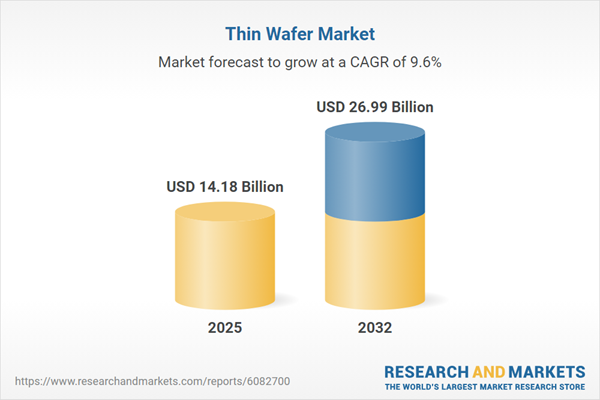Speak directly to the analyst to clarify any post sales queries you may have.
The thin wafer market is driving essential changes in high-performance electronics manufacturing, enabling lighter, more robust, and flexible devices for a diverse set of industries. As companies pursue enhanced process control and innovative material technologies, the thin wafer market is on track for substantial, sustained expansion in the coming years.
Market Snapshot: Thin Wafer Market Growth and Outlook
The Thin Wafer Market grew from USD 12.98 billion in 2024 to USD 14.18 billion in 2025. It is expected to continue growing at a CAGR of 9.57%, reaching USD 26.99 billion by 2032. Demand is accelerating as high-precision thinning, polishing, and advanced wafer processing establish new performance standards across major sectors. Growth is further propelled by the adoption of cutting-edge technologies and realignment of global supply chains, increasing relevance for both established and emerging market leaders.
Scope & Segmentation Across Thin Wafer Applications
- Material Types: Gallium arsenide, silicon
- Wafer Sizes: 125 mm, 200 mm, 300 mm
- Manufacturing Processes: Etching (dry and wet), grinding (coarse, fine, TAIKO process), polishing, temporary bonding & debonding
- Applications: Flexible electronics, micro-electro-mechanical systems, microelectronics, photonics, power devices
- End-Use Industries: Automotive, consumer electronics, healthcare, telecommunication infrastructure
- Regions: Americas (North America, Latin America), Europe, Middle East & Africa, Asia-Pacific
- Key Companies: 3M Company, Aixtron SE, Atecom Technology Co., Ltd., Brewer Science, Inc., Chipmetrics Oy, DISCO Corporation, EV Group, Globalwafers Co., Ltd., Hangzhou Semiconductor Wafer Co., Ltd., Hemlock Semiconductor Corporation, KYOCERA AVX Components Corporation, LDK Solar High-Tech Co., Ltd., MEMC Electronic Materials, Inc., Okmetic Oy, Shin-Etsu Chemical Co., Ltd., Siltronic AG, Siltronix Silicon Technologies, SK Siltron Co., Ltd., Soitec, SPTS Technologies Ltd., Sumco Corporation, SÜSS MicroTec SE, UniversityWafer, Inc., Virginia Semiconductor Inc., Wafer World Inc.
Key Takeaways for Senior Decision-Makers
- Advancements in deep ultraviolet lithography, nanometer-scale etching, and surface conditioning processes allow for the production of ultra-thin substrates, enabling new possibilities for flexible and high-performance devices.
- Vertical integration and digital transformation are accelerating innovation cycles, fostering the rapid adoption of customized wafer solutions tailored to electric vehicles, next-generation power modules, and flexible displays.
- Strategic partnerships are reshaping competitive dynamics, as material innovators, equipment vendors, and end customers collaborate to accelerate process development and share knowledge across the value chain.
- The shift toward localized wafer processing and onshore equipment deployment is enhancing supply chain resilience and reducing exposure to geopolitical and tariff risks.
- Value-added services, including design-for-manufacturability consulting and failure analysis, are helping market leaders create recurring revenue streams and forge stronger customer relationships.
Tariff Impact: Navigating Regulatory Pressures on Thin Wafer Supply Chains
New tariffs enacted by the United States in 2025 are prompting manufacturers to reconfigure cross-border logistics, prioritize localized production, and renegotiate supply agreements. Companies are leveraging free trade zones and onshore investment in advanced processing equipment to maintain margin performance and ensure long-term access to critical raw materials and technologies. These shifts also highlight the premium placed on operational flexibility, strategic alliances, and supply chain resilience.
Methodology & Data Sources Behind the Thin Wafer Study
This report is built on comprehensive research protocols, including review of technical literature, interviews with industry specialists, and triangulated data validation with proprietary case studies. Analytical frameworks integrate both qualitative assessments and quantitative benchmarks drawn from live production environments, ensuring actionable and thoroughly validated insights for stakeholders.
Why This Report Matters in the Thin Wafer Market
- Actionable insights on market-defining technologies and strategies help decision-makers navigate evolving technology landscapes and regulatory frameworks.
- Detailed segmentation enables leaders to create tailored growth strategies, achieve yield improvements, and address sustainability imperatives across their value chains.
- Comprehensive regional analysis supports global expansion, risk mitigation, and effective resource allocation in a dynamic semiconductor industry.
Conclusion & Next Steps
Organizations that pursue integrated innovation, agile supply chain management, and holistic sustainability practices are positioned to capture emerging opportunities in the thin wafer market. Strategic partnerships, talent cultivation, and digital transformation will drive the next phase of competitive advantage.
Table of Contents
3. Executive Summary
4. Market Overview
7. Cumulative Impact of Artificial Intelligence 2025
Companies Mentioned
The companies profiled in this Thin Wafer market report include:- 3M Company
- Aixtron SE
- Atecom Technology Co., Ltd.
- Brewer Science, Inc.
- Chipmetrics Oy
- DISCO Corporation
- EV Group
- Globalwafers Co., Ltd.
- Hangzhou Semiconductor Wafer Co., Ltd .
- Hemlock Semiconductor Corporation
- KYOCERA AVX Components Corporation
- LDK Solar High-Tech Co., Ltd.
- MEMC Electronic Materials, Inc.
- Okmetic Oy
- Shin-Etsu Chemical Co., Ltd.
- Siltronic AG
- Siltronix Silicon Technologies
- SK Siltron Co., Ltd.
- Soitec
- SPTS Technologies Ltd.
- Sumco Corporation
- SÜSS MicroTec SE
- UniversityWafer, Inc.
- Virginia Semiconductor Inc.
- Wafer World Inc.
Table Information
| Report Attribute | Details |
|---|---|
| No. of Pages | 184 |
| Published | November 2025 |
| Forecast Period | 2025 - 2032 |
| Estimated Market Value ( USD | $ 14.18 Billion |
| Forecasted Market Value ( USD | $ 26.99 Billion |
| Compound Annual Growth Rate | 9.5% |
| Regions Covered | Global |
| No. of Companies Mentioned | 26 |









